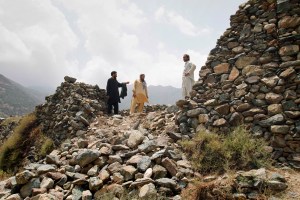
In this June 28, 2011 photo, Afghan villagers in Kunar province stand near the wall of a residential compound hit by a Pakistani artillery shell. (AP Photo/Rahmat Gul)
The specter of unintended consequences has haunted most military decisions made since the U.S. declared its war on terror nearly a decade ago. And so it should not be surprising that the death of Osama bin Laden — once envisioned as the blow to end this now-global fight — may itself be causing a fresh and unforeseen aftershock in the lives of the people living at its epicenter.
In the past three months, up to 12,000 civilians in eastern Afghanistan have been displaced by an increasingly regular drumming of shells from across the porous, ill-defined border with Pakistan. The villages and hamlets in Kunar and Nangarhar provinces have been reporting sporadic shelling and gunfire coming from their neighbor since the beginning of the year. But since the clandestine May mission in Abbottabad that killed bin Laden, the Pakistani army has upped its own fight against militants in the border region.
“The daily shelling started around June,” says Ilija Todorovic, head of the suboffice of the United Nations High Commissioner for Refugees (UNCHR) in eastern Afghanistan. “From what I’m hearing, this will continue.” He says the impact of the shells on the isolated clusters of homes in the mountainous swath of northeast Afghanistan has varied, but whatever the physical damage done, “it causes fear. Villagers leave. Some immediately; some go in the morning.”
(Watch a video about the U.S. fight in Afghanistan.)
The ongoing shelling, which Kabul estimates has killed nearly 50 people, has been a source of growing tension between the neighboring states. Earlier this week hundreds of protestors gathered in Lashkar Gah, the capital of Helmand province, and the eastern city of Jalalabad to demand that President Hamid Karzai fire back across the border, an act of retaliation that the Afghan leader, whose half-brother was assassinated yesterday in Kandahar, has so far resisted despite the wishes of some members of his own cabinet. Kabul estimates that more than 800 rockets have been fired into Afghanistan in the last month alone.
Pakistan, for its part, has countered that it, too, has been attacked by militants hiding out on the Afghanistan side of the border, and says that its neighbor’s claims of shelling are exaggerated. “There may have been few civilian casualties, but now the situation is under control,” Pakistan’s chief military spokesman told the Wall Street Journal.
But civilians in western Pakistan, too, have been fleeing their homes as the anti-insurgency campaign intensified last month. Tens of thousands of people have already left their homes in Pakistan’s Kurram agency along the border with Afghanistan. Local authorities say numbers could eventually rise to nearly 85,000 as the clamp down continues. In the last three years, conflict between Pakistan’s army and militants in the northwest have displaced four million people, according to the UNHCR.
During past military interventions in Pakistan’s border areas, thousands of Pakistanis have escaped west to Afghanistan, seeking shelter with the same families that had lived with them before the fall of the Taliban. That hasn’t occurred yet in this campaign, but Todorvoric doesn’t rule it out. “Afghans remember those links with Pakistanis on the other side, and they are paying back the hospitality,” he says. “They take care of each other.”
Those ties are as important now as ever. Further escalation in cross-border tensions and between Kabul and Islamabad could have grim consequences — and not just for the civilians living on either side of this rugged, sparsely populated landscape. Most of the 12,000 displaced Afghans are now staying with extended family or community members, waiting to go home to their farms and herds when things quiet down. But their homeland has long been a transit area for militants between Pakistan and Kabul, and a continuing disturbance to daily life there may build resentment and draw people to the insurgents’ cause as the U.S. military begins to withdraw its troops.
“You name any anti-government element – they’ve passed through there,” Todorovic says. “The area is insecure to begin with. The longer people remain displaced, and if they are unable to return, it can destabilize the situation. It will make it more volatile.”
Krista Mahr is a reporter at TIME. Find her on Twitter at @kristamahr. You can also continue the discussion on TIME’s Facebook page and on Twitter at @TIME.

